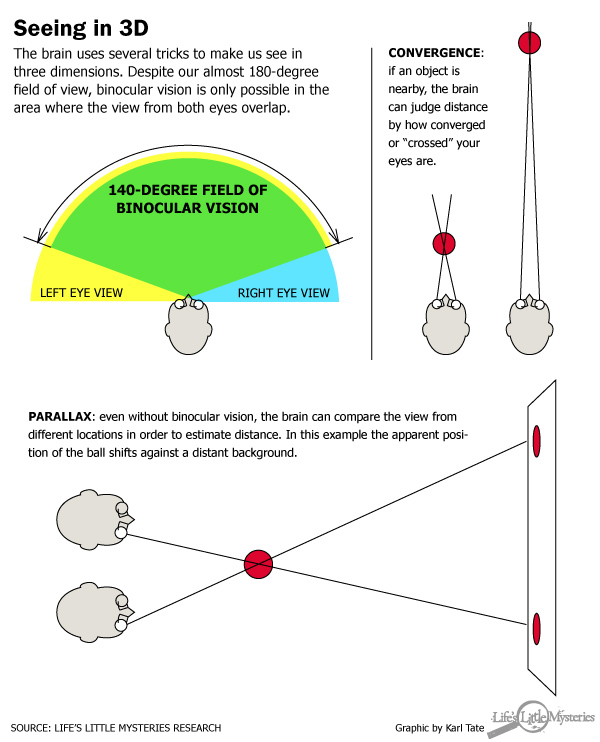Why Do We See in 3D?
When it comes to seeing in 3-D, two eyes are better than one. To see how 3-D vision works, hold a finger at arm's length and look at it through one eye, then through the other. See how the image seems to jump? That's because of binocular disparity, the slight difference between the images seen by each eye.
Binocular disparity is one of the most important pieces of information the visual centers of the brain use to reconstruct the depth of a scene.
If the object you're trying to view is close to you, the brain uses another clue: convergence, or the angle of your eyes as you focus on an object. Crossing your eyes will give you an extreme example of the convergence sensation.
But even without binocular vision, it's possible to judge depth. Animals without overlapping visual fields rely heavily on something called parallax, which is the difference in speed at which closer and farther objects seem to move as you pass them. For example, fence posts along the side of a highway will fly by, while a grain silo a quarter-mile from the road will seem to creep. Our brain has a built-in processing center for this phenomenon, according to a 2008 Nature study. An area behind the ear called the middle temporal region carries information about parallax, and may synthesize it with other depth cues.

Other means of perceiving depth using just one eye involve cues including object size, parallel lines that appear to converge, sharper textures in closer objects, and the way objects overlap.
Even with all these cues at its disposal, the brain makes mistakes. Artists can trick the brain into seeing a 2-D painting in three dimensions by drawing converging parallel lines and painting "closer" objects in greater detail.
Gym class can be a bummer for the visual system, as well: According to a 2008 study in the journal Proceedings of the National Academy of Sciences, our brains take shortcuts based on previous experience when judging depth. Because most objects we encounter move relatively slowly, we may misjudge the distance of fast-moving objects like a soccer ball headed for our face.
Sign up for the Live Science daily newsletter now
Get the world’s most fascinating discoveries delivered straight to your inbox.

Stephanie Pappas is a contributing writer for Live Science, covering topics ranging from geoscience to archaeology to the human brain and behavior. She was previously a senior writer for Live Science but is now a freelancer based in Denver, Colorado, and regularly contributes to Scientific American and The Monitor, the monthly magazine of the American Psychological Association. Stephanie received a bachelor's degree in psychology from the University of South Carolina and a graduate certificate in science communication from the University of California, Santa Cruz.









